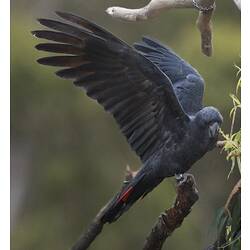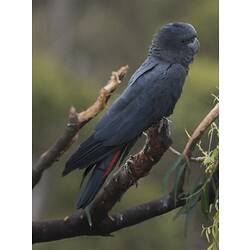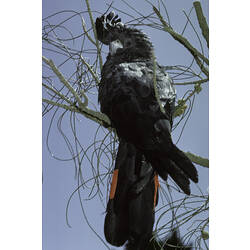General Description
A large, noisy bird with a distinctive call ("karak, karak") and a crest that can be brought above the head and over the beak. The males are glossy black with striking red tail panels and grey beaks. The females and juveniles are black-brown with yellow speckles on their head, neck and wings; orange-yellow barring on their undersides; and cream beaks. The males develop their adult-colouration at about 3 years. Adult males can reach 60 cm long and 900 g.
Biology
This is one of five subspecies of Red-tailed Black Cockatoos and was the mascot of the 2006 Melbourne Commonwealth Games. In the breeding season (September to December), Red-tailed Blacks usually feed alone or in small family groups of 2-3 birds. In the non-breeding season, they feed in large groups. The species has a highly-specialised diet, feeding almost exclusively on the seeds of three tree species: Brown Stringybark, Desert Stringybark and, in summer and early autumn, Buloke. They nest in deep tree hollows in large, old (usually dead) eucalypts, laying a single egg each breeding season. The subspecies is highly threatened due to the destruction of its nesting and food trees; only a single population of about 1400 individuals remains.
Distribution
South-western Victoria and south-eastern South Australia.
Habitat
Stringybark and Buloke woodlands (at least 10 years post-fire and containing 100+ year old nesting trees).
More Information
-
Animal Type
-
Animal SubType
-
Brief Id
Large bird with a black crest. Male: glossy black, red tail panels. Female: black-brown with yellow speckles; orange-yellow barred underside.
-
Maximum Size
60 cm
-
Habitats
-
Diet
Herbivore
-
Endemicity
-
Commercial
No
-
Conservation Statuses
CITES: Trade restrictions (Appendix II), FFG Threatened List: Endangered, EPBC Act 1999: Endangered, IUCN Red List: Not listed
-
Taxon Name
-
Common Name
Red-tailed Black-Cockatoo
-
Kingdom
-
Phylum
-
Subphylum
-
Class
-
Order
-
Family
-
Genus
-
Species Name
banksii
-
Subspecies
graptogyne




